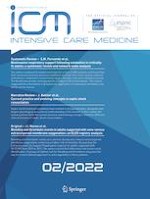Erschienen in:

26.10.2021 | Correspondence
Do we have sufficient evidence to support the use of inotropes in patients with sepsis?
verfasst von:
Ryota Sato, Daisuke Hasegawa, Siddharth Dugar
Erschienen in:
Intensive Care Medicine
|
Ausgabe 2/2022
Einloggen, um Zugang zu erhalten
Excerpt
We read with great interest the Surviving Sepsis Campaign 2021 [
1]. In this guideline, the authors suggested either adding dobutamine to norepinephrine or using epinephrine alone in the setting of septic shock and cardiac dysfunction with persistent hypoperfusion despite adequate volume resuscitation and arterial blood pressure. In the rationale to support this recommendation, the authors stated that these recommendations are based on the results from the network meta-analysis by Belletti et al. [
2]. However, this network meta-analysis showed no significant differences among norepinephrine alone, norepinephrine and dobutamine, or epinephrine alone. This suggests that the use of inotropes does not necessarily improve mortality in septic patients. In addition, the definition of cardiac dysfunction and hypoperfusion stated in this recommendation remains vague with varying interpretations by differing bedside clinicians on what constitutes cardiac dysfunction. Even though the authors stated that sepsis-induced myocardial dysfunction is associated with worse outcomes in the rationale, sepsis-induced myocardial dysfunction has a wide variety of presentations including left and/or right, systolic and/or diastolic dysfunction and there is no established evidence regarding the association especially between left ventricular systolic dysfunction and mortality in septic patients. Therefore, clinicians need to be cautious about what cardiac dysfunction in this recommendation means. …